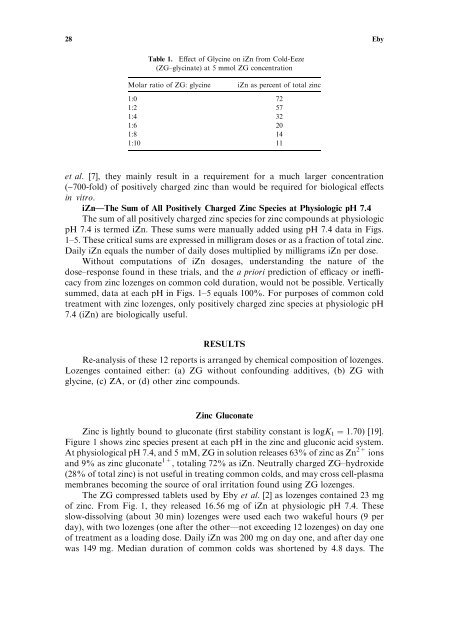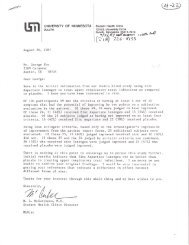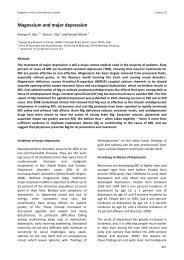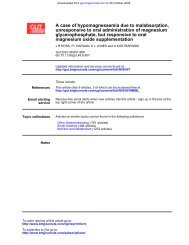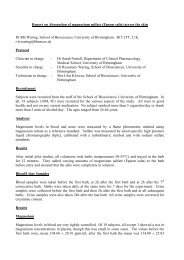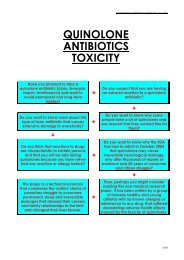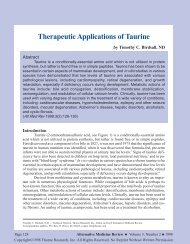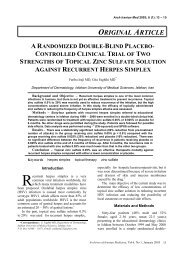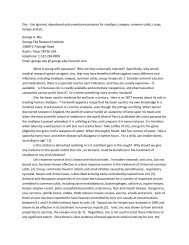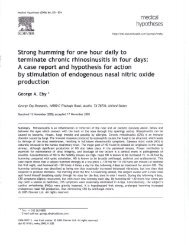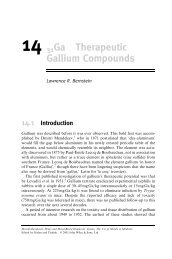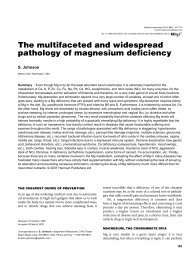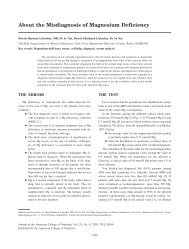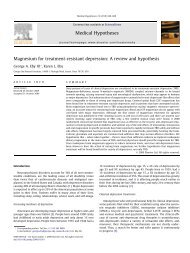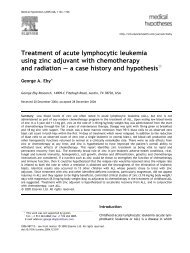Zinc Lozenges: Cold Cure or Candy? - Bioscience Reports
Zinc Lozenges: Cold Cure or Candy? - Bioscience Reports
Zinc Lozenges: Cold Cure or Candy? - Bioscience Reports
You also want an ePaper? Increase the reach of your titles
YUMPU automatically turns print PDFs into web optimized ePapers that Google loves.
28 Eby<br />
Table 1. Effect of Glycine on iZn from <strong>Cold</strong>-Eeze<br />
(ZG–glycinate) at 5 mmol ZG concentration<br />
Molar ratio of ZG: glycine<br />
iZn as percent of total zinc<br />
1:0 72<br />
1:2 57<br />
1:4 32<br />
1:6 20<br />
1:8 14<br />
1:10 11<br />
et al. [7], they mainly result in a requirement f<strong>or</strong> a much larger concentration<br />
(~700-fold) of positively charged zinc than would be required f<strong>or</strong> biological effects<br />
in vitro.<br />
iZn—The Sum of All Positively Charged <strong>Zinc</strong> Species at Physiologic pH 7.4<br />
The sum of all positively charged zinc species f<strong>or</strong> zinc compounds at physiologic<br />
pH 7.4 is termed iZn. These sums were manually added using pH 7.4 data in Figs.<br />
1–5. These critical sums are expressed in milligram doses <strong>or</strong> as a fraction of total zinc.<br />
Daily iZn equals the number of daily doses multiplied by milligrams iZn per dose.<br />
Without computations of iZn dosages, understanding the nature of the<br />
dose–response found in these trials, and the a pri<strong>or</strong>i prediction of efficacy <strong>or</strong> inefficacy<br />
from zinc lozenges on common cold duration, would not be possible. Vertically<br />
summed, data at each pH in Figs. 1–5 equals 100%. F<strong>or</strong> purposes of common cold<br />
treatment with zinc lozenges, only positively charged zinc species at physiologic pH<br />
7.4 (iZn) are biologically useful.<br />
RESULTS<br />
Re-analysis of these 12 rep<strong>or</strong>ts is arranged by chemical composition of lozenges.<br />
<strong>Lozenges</strong> contained either: (a) ZG without confounding additives, (b) ZG with<br />
glycine, (c) ZA, <strong>or</strong> (d) other zinc compounds.<br />
<strong>Zinc</strong> Gluconate<br />
<strong>Zinc</strong> is lightly bound to gluconate (first stability constant is logK 1 ¼ 1.70) [19].<br />
Figure 1 shows zinc species present at each pH in the zinc and gluconic acid system.<br />
At physiological pH 7.4, and 5 mM, ZG in solution releases 63% of zinc as Zn 2+ ions<br />
and 9% as zinc gluconate 1+ , totaling 72% as iZn. Neutrally charged ZG–hydroxide<br />
(28% of total zinc) is not useful in treating common colds, and may cross cell-plasma<br />
membranes becoming the source of <strong>or</strong>al irritation found using ZG lozenges.<br />
The ZG compressed tablets used by Eby et al. [2] as lozenges contained 23 mg<br />
of zinc. From Fig. 1, they released 16.56 mg of iZn at physiologic pH 7.4. These<br />
slow-dissolving (about 30 min) lozenges were used each two wakeful hours (9 per<br />
day), with two lozenges (one after the other—not exceeding 12 lozenges) on day one<br />
of treatment as a loading dose. Daily iZn was 200 mg on day one, and after day one<br />
was 149 mg. Median duration of common colds was sh<strong>or</strong>tened by 4.8 days. The


